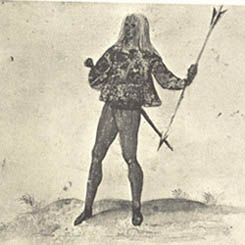I have seen a few "darts" over the years in paintings. What differentiates a dart (the weapon) from say a javelin (characteristics)? Additionally, were all darts fletched with feathers or have fins? Also, who used them and in what way were they used?
In my recent foray into learning about thrown weapons. I cam across the Swiss arrow http://en.wikipedia.org/wiki/Swiss_arrow. Technically not an arrow but a dart and apparently a favorite of British school boys in certain areas.
It seems that the difference in darts and javelins seems to be the fletching. Darts also seem to be lighter and more flexible than a javelin while being unstable to use in a bow. If it is too light to be used in combat except in dire emergencies than it is probably a dart. Think the darts an atlatl uses. Typically while long enough to be a spear they are usually to light and flexible to do anything but break in a fight.
It seems that the difference in darts and javelins seems to be the fletching. Darts also seem to be lighter and more flexible than a javelin while being unstable to use in a bow. If it is too light to be used in combat except in dire emergencies than it is probably a dart. Think the darts an atlatl uses. Typically while long enough to be a spear they are usually to light and flexible to do anything but break in a fight.
Although I don't doubt that there is a particular weapon called a 'Dart', I get the impression that the term is often used by period writers as simply meaning 'Javelin'. Medieval and Ancient authors have a habit of using terms, that we today would only apply in specific sense, interchangeably or generally.
I agree with David. In french you will see the authors refer to ''dards''as javelins, and french was used extensively for the longest period of time, before english came into its' own. It is therefore to be expected that the litteral translation of ''dards'' to ''darts'' would come about without any consideration to more exotic weapons. That does not mean that these other weapons did not exist, but one should look at the context. For example, when referring to the ''dards'' used by the Breton light cavalry against the Frankish invaders, we are surely referring to javelins.
Apparently Sean Flynn already started this topic in 2006. http://www.myArmoury.com/talk/viewtopic.php?t...mp;start=0 He is such a fascinating topic starter. I was thinking about purchasing some A&A Javelins and fletching them to make darts. Maybe someone with more knowledge could tell me if that would be even remotely accurate.
 Attachment: 41.66 KB
Attachment: 41.66 KB


I realise I am using Graves' fictionalised acount as if it were history here, but weren't the Byzantine cataphractoi armed with three "darts" on the inside of their shields? If this is even remotely based on actual history I imagine they would be a fair way from javelins (I wouldn't ant 3 javelins weighing my shield down). I thought they were more like overly heavy crossbow bolts, but perhaps with heavier heads. But like I said, image mostly formed reading Count Balasarius,
| Nat Lamb wrote: |
| I realise I am using Graves' fictionalised acount as if it were history here, but weren't the Byzantine cataphractoi armed with three "darts" on the inside of their shields? If this is even remotely based on actual history I imagine they would be a fair way from javelins (I wouldn't ant 3 javelins weighing my shield down). I thought they were more like overly heavy crossbow bolts, but perhaps with heavier heads. But like I said, image mostly formed reading Count Balasarius, |
Read this: http://wapedia.mobi/en/Plumbata_(dart)
The short answer would be " YES " these were used by Roman infantry and the Byzantines.
These are actually found fairly often in ship and castle inventories. You also see them in artwork. In the late 13th a warship from southampton had about 200plus on board. I have no idea if a real difference exists between them though as thye have loads of names in the medieval period for the same object.
RPM
RPM
| Jean Thibodeau wrote: | ||
Read this: http://wapedia.mobi/en/Plumbata_(dart) The short answer would be " YES " these were used by Roman infantry and the Byzantines. |
It's not mentioned in Procopius, though; the Eastern Roman cavalry there used bows and occasionally swords or lances, with no signs of darts anywhere on the scene. So I have rather strong doubts that Belisarius's cavalrymen still carried the plumbatae even though earlier Late Roman cavalry might have done so.
Page 1 of 1
You cannot post new topics in this forumYou cannot reply to topics in this forum
You cannot edit your posts in this forum
You cannot delete your posts in this forum
You cannot vote in polls in this forum
You cannot attach files in this forum
You can download files in this forum
All contents © Copyright 2003-2006 myArmoury.com — All rights reserved
Discussion forums powered by phpBB © The phpBB Group
Switch to the Full-featured Version of the forum
Discussion forums powered by phpBB © The phpBB Group
Switch to the Full-featured Version of the forum